Zhengrong Xue
DemoSpeedup: Accelerating Visuomotor Policies via Entropy-Guided Demonstration Acceleration
Jun 05, 2025Abstract:Imitation learning has shown great promise in robotic manipulation, but the policy's execution is often unsatisfactorily slow due to commonly tardy demonstrations collected by human operators. In this work, we present DemoSpeedup, a self-supervised method to accelerate visuomotor policy execution via entropy-guided demonstration acceleration. DemoSpeedup starts from training an arbitrary generative policy (e.g., ACT or Diffusion Policy) on normal-speed demonstrations, which serves as a per-frame action entropy estimator. The key insight is that frames with lower action entropy estimates call for more consistent policy behaviors, which often indicate the demands for higher-precision operations. In contrast, frames with higher entropy estimates correspond to more casual sections, and therefore can be more safely accelerated. Thus, we segment the original demonstrations according to the estimated entropy, and accelerate them by down-sampling at rates that increase with the entropy values. Trained with the speedup demonstrations, the resulting policies execute up to 3 times faster while maintaining the task completion performance. Interestingly, these policies could even achieve higher success rates than those trained with normal-speed demonstrations, due to the benefits of reduced decision-making horizons.
H$^{\mathbf{3}}$DP: Triply-Hierarchical Diffusion Policy for Visuomotor Learning
May 12, 2025Abstract:Visuomotor policy learning has witnessed substantial progress in robotic manipulation, with recent approaches predominantly relying on generative models to model the action distribution. However, these methods often overlook the critical coupling between visual perception and action prediction. In this work, we introduce $\textbf{Triply-Hierarchical Diffusion Policy}~(\textbf{H$^{\mathbf{3}}$DP})$, a novel visuomotor learning framework that explicitly incorporates hierarchical structures to strengthen the integration between visual features and action generation. H$^{3}$DP contains $\mathbf{3}$ levels of hierarchy: (1) depth-aware input layering that organizes RGB-D observations based on depth information; (2) multi-scale visual representations that encode semantic features at varying levels of granularity; and (3) a hierarchically conditioned diffusion process that aligns the generation of coarse-to-fine actions with corresponding visual features. Extensive experiments demonstrate that H$^{3}$DP yields a $\mathbf{+27.5\%}$ average relative improvement over baselines across $\mathbf{44}$ simulation tasks and achieves superior performance in $\mathbf{4}$ challenging bimanual real-world manipulation tasks. Project Page: https://lyy-iiis.github.io/h3dp/.
DemoGen: Synthetic Demonstration Generation for Data-Efficient Visuomotor Policy Learning
Feb 24, 2025
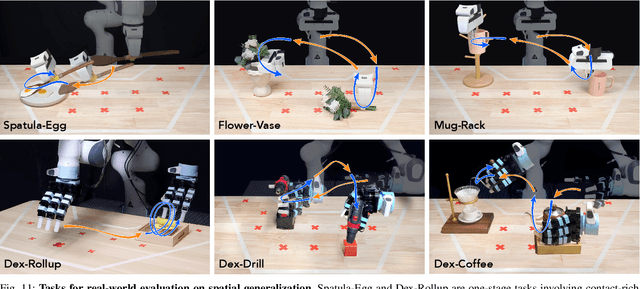
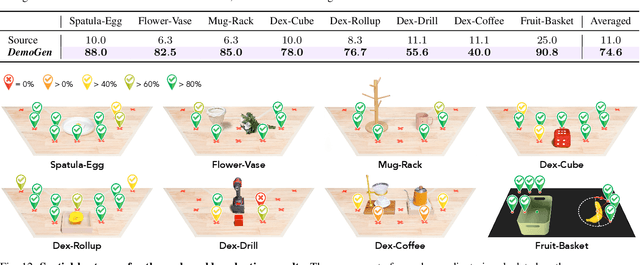
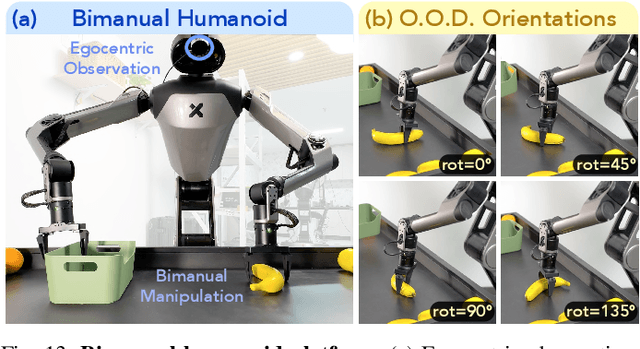
Abstract:Visuomotor policies have shown great promise in robotic manipulation but often require substantial amounts of human-collected data for effective performance. A key reason underlying the data demands is their limited spatial generalization capability, which necessitates extensive data collection across different object configurations. In this work, we present DemoGen, a low-cost, fully synthetic approach for automatic demonstration generation. Using only one human-collected demonstration per task, DemoGen generates spatially augmented demonstrations by adapting the demonstrated action trajectory to novel object configurations. Visual observations are synthesized by leveraging 3D point clouds as the modality and rearranging the subjects in the scene via 3D editing. Empirically, DemoGen significantly enhances policy performance across a diverse range of real-world manipulation tasks, showing its applicability even in challenging scenarios involving deformable objects, dexterous hand end-effectors, and bimanual platforms. Furthermore, DemoGen can be extended to enable additional out-of-distribution capabilities, including disturbance resistance and obstacle avoidance.
MENTOR: Mixture-of-Experts Network with Task-Oriented Perturbation for Visual Reinforcement Learning
Oct 19, 2024

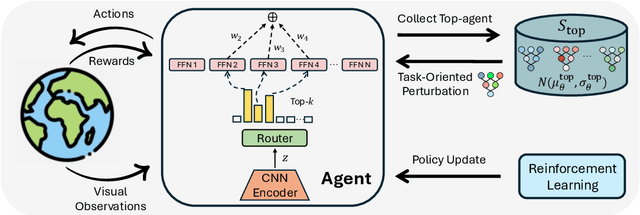
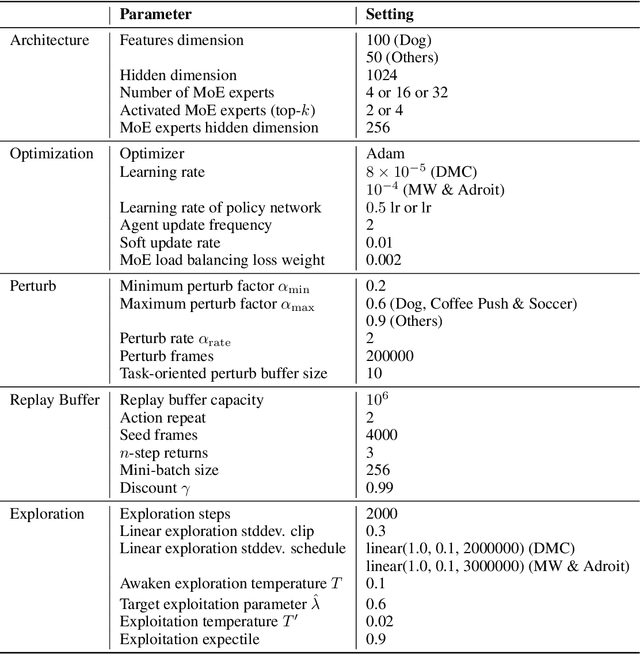
Abstract:Visual deep reinforcement learning (RL) enables robots to acquire skills from visual input for unstructured tasks. However, current algorithms suffer from low sample efficiency, limiting their practical applicability. In this work, we present MENTOR, a method that improves both the architecture and optimization of RL agents. Specifically, MENTOR replaces the standard multi-layer perceptron (MLP) with a mixture-of-experts (MoE) backbone, enhancing the agent's ability to handle complex tasks by leveraging modular expert learning to avoid gradient conflicts. Furthermore, MENTOR introduces a task-oriented perturbation mechanism, which heuristically samples perturbation candidates containing task-relevant information, leading to more targeted and effective optimization. MENTOR outperforms state-of-the-art methods across three simulation domains -- DeepMind Control Suite, Meta-World, and Adroit. Additionally, MENTOR achieves an average of 83% success rate on three challenging real-world robotic manipulation tasks including peg insertion, cable routing, and tabletop golf, which significantly surpasses the success rate of 32% from the current strongest model-free visual RL algorithm. These results underscore the importance of sample efficiency in advancing visual RL for real-world robotics. Experimental videos are available at https://suninghuang19.github.io/mentor_page.
Key-Grid: Unsupervised 3D Keypoints Detection using Grid Heatmap Features
Oct 03, 2024

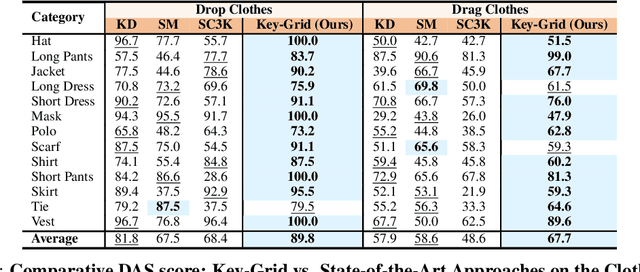
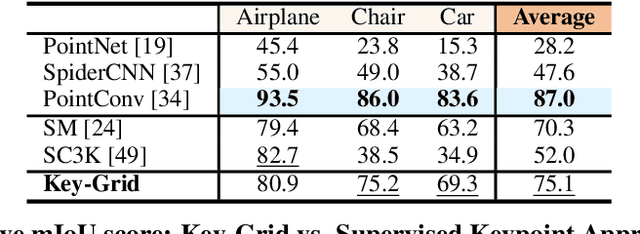
Abstract:Detecting 3D keypoints with semantic consistency is widely used in many scenarios such as pose estimation, shape registration and robotics. Currently, most unsupervised 3D keypoint detection methods focus on the rigid-body objects. However, when faced with deformable objects, the keypoints they identify do not preserve semantic consistency well. In this paper, we introduce an innovative unsupervised keypoint detector Key-Grid for both the rigid-body and deformable objects, which is an autoencoder framework. The encoder predicts keypoints and the decoder utilizes the generated keypoints to reconstruct the objects. Unlike previous work, we leverage the identified keypoint in formation to form a 3D grid feature heatmap called grid heatmap, which is used in the decoder section. Grid heatmap is a novel concept that represents the latent variables for grid points sampled uniformly in the 3D cubic space, where these variables are the shortest distance between the grid points and the skeleton connected by keypoint pairs. Meanwhile, we incorporate the information from each layer of the encoder into the decoder section. We conduct an extensive evaluation of Key-Grid on a list of benchmark datasets. Key-Grid achieves the state-of-the-art performance on the semantic consistency and position accuracy of keypoints. Moreover, we demonstrate the robustness of Key-Grid to noise and downsampling. In addition, we achieve SE-(3) invariance of keypoints though generalizing Key-Grid to a SE(3)-invariant backbone.
AToM-Bot: Embodied Fulfillment of Unspoken Human Needs with Affective Theory of Mind
Jun 12, 2024



Abstract:We propose AToM-Bot, a novel task generation and execution framework for proactive robot-human interaction, which leverages the human mental and physical state inference capabilities of the Vision Language Model (VLM) prompted by the Affective Theory of Mind (AToM). Without requiring explicit commands by humans, AToM-Bot proactively generates and follows feasible tasks to improve general human well-being. When around humans, AToM-Bot first detects current human needs based on inferred human states and observations of the surrounding environment. It then generates tasks to fulfill these needs, taking into account its embodied constraints. We designed 16 daily life scenarios spanning 4 common scenes and tasked the same visual stimulus to 59 human subjects and our robot. We used the similarity between human open-ended answers and robot output, and the human satisfaction scores to metric robot performance. AToM-Bot received high human evaluations in need detection (6.42/7, 91.7%), embodied solution (6.15/7, 87.8%) and task execution (6.17/7, 88.1%). We show that AToM-Bot excels in generating and executing feasible plans to fulfill unspoken human needs. Videos and code are available at https://affective-tom-bot.github.io.
RiEMann: Near Real-Time SE-Equivariant Robot Manipulation without Point Cloud Segmentation
Mar 28, 2024



Abstract:We present RiEMann, an end-to-end near Real-time SE(3)-Equivariant Robot Manipulation imitation learning framework from scene point cloud input. Compared to previous methods that rely on descriptor field matching, RiEMann directly predicts the target poses of objects for manipulation without any object segmentation. RiEMann learns a manipulation task from scratch with 5 to 10 demonstrations, generalizes to unseen SE(3) transformations and instances of target objects, resists visual interference of distracting objects, and follows the near real-time pose change of the target object. The scalable action space of RiEMann facilitates the addition of custom equivariant actions such as the direction of turning the faucet, which makes articulated object manipulation possible for RiEMann. In simulation and real-world 6-DOF robot manipulation experiments, we test RiEMann on 5 categories of manipulation tasks with a total of 25 variants and show that RiEMann outperforms baselines in both task success rates and SE(3) geodesic distance errors on predicted poses (reduced by 68.6%), and achieves a 5.4 frames per second (FPS) network inference speed. Code and video results are available at https://riemann-web.github.io/.
OTAS: Unsupervised Boundary Detection for Object-Centric Temporal Action Segmentation
Sep 12, 2023Abstract:Temporal action segmentation is typically achieved by discovering the dramatic variances in global visual descriptors. In this paper, we explore the merits of local features by proposing the unsupervised framework of Object-centric Temporal Action Segmentation (OTAS). Broadly speaking, OTAS consists of self-supervised global and local feature extraction modules as well as a boundary selection module that fuses the features and detects salient boundaries for action segmentation. As a second contribution, we discuss the pros and cons of existing frame-level and boundary-level evaluation metrics. Through extensive experiments, we find OTAS is superior to the previous state-of-the-art method by $41\%$ on average in terms of our recommended F1 score. Surprisingly, OTAS even outperforms the ground-truth human annotations in the user study. Moreover, OTAS is efficient enough to allow real-time inference.
ArrayBot: Reinforcement Learning for Generalizable Distributed Manipulation through Touch
Jun 29, 2023Abstract:We present ArrayBot, a distributed manipulation system consisting of a $16 \times 16$ array of vertically sliding pillars integrated with tactile sensors, which can simultaneously support, perceive, and manipulate the tabletop objects. Towards generalizable distributed manipulation, we leverage reinforcement learning (RL) algorithms for the automatic discovery of control policies. In the face of the massively redundant actions, we propose to reshape the action space by considering the spatially local action patch and the low-frequency actions in the frequency domain. With this reshaped action space, we train RL agents that can relocate diverse objects through tactile observations only. Surprisingly, we find that the discovered policy can not only generalize to unseen object shapes in the simulator but also transfer to the physical robot without any domain randomization. Leveraging the deployed policy, we present abundant real-world manipulation tasks, illustrating the vast potential of RL on ArrayBot for distributed manipulation.
Pre-Trained Image Encoder for Generalizable Visual Reinforcement Learning
Dec 17, 2022Abstract:Learning generalizable policies that can adapt to unseen environments remains challenging in visual Reinforcement Learning (RL). Existing approaches try to acquire a robust representation via diversifying the appearances of in-domain observations for better generalization. Limited by the specific observations of the environment, these methods ignore the possibility of exploring diverse real-world image datasets. In this paper, we investigate how a visual RL agent would benefit from the off-the-shelf visual representations. Surprisingly, we find that the early layers in an ImageNet pre-trained ResNet model could provide rather generalizable representations for visual RL. Hence, we propose Pre-trained Image Encoder for Generalizable visual reinforcement learning (PIE-G), a simple yet effective framework that can generalize to the unseen visual scenarios in a zero-shot manner. Extensive experiments are conducted on DMControl Generalization Benchmark, DMControl Manipulation Tasks, Drawer World, and CARLA to verify the effectiveness of PIE-G. Empirical evidence suggests PIE-G improves sample efficiency and significantly outperforms previous state-of-the-art methods in terms of generalization performance. In particular, PIE-G boasts a 55% generalization performance gain on average in the challenging video background setting. Project Page: https://sites.google.com/view/pie-g/home.
 Add to Chrome
Add to Chrome Add to Firefox
Add to Firefox Add to Edge
Add to Edge